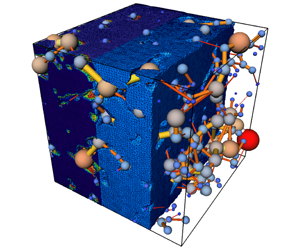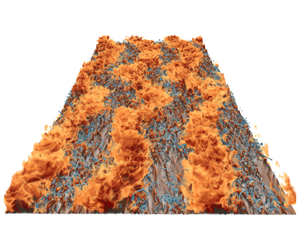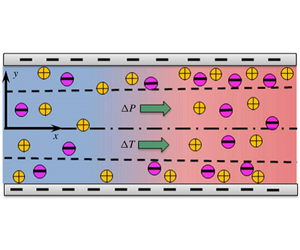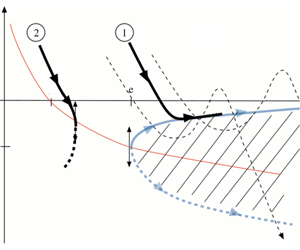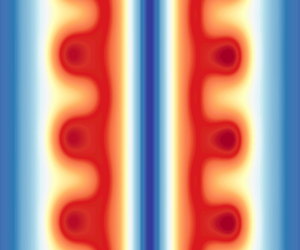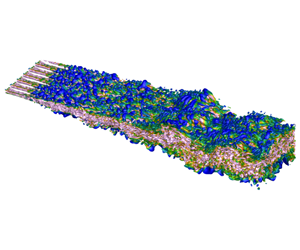The flow-induced vibrations of an elastically mounted circular cylinder, free to oscillate in the streamwise and cross-flow directions, and forced to rotate about its axis, are investigated via two- and three-dimensional simulations. The Reynolds number based on the body diameter and inflow velocity is equal to  $100$. The impact of the imposed rotation on the flow–structure system behaviour is explored over wide ranges of values of the rotation rate (ratio between the cylinder surface and inflow velocities,
$100$. The impact of the imposed rotation on the flow–structure system behaviour is explored over wide ranges of values of the rotation rate (ratio between the cylinder surface and inflow velocities,  $\unicode[STIX]{x1D6FC}\in [0,5.5]$) and of the reduced velocity (inverse of the oscillator natural frequency non-dimensionalized by the inflow velocity and body diameter,
$\unicode[STIX]{x1D6FC}\in [0,5.5]$) and of the reduced velocity (inverse of the oscillator natural frequency non-dimensionalized by the inflow velocity and body diameter,  $U^{\star }\in [1,25]$). Flow-induced vibrations are found to develop over the entire range of
$U^{\star }\in [1,25]$). Flow-induced vibrations are found to develop over the entire range of  $\unicode[STIX]{x1D6FC}$, including in the intervals where the imposed rotation cancels flow unsteadiness when the body is rigidly mounted (i.e. not allowed to translate). The responses of the two-degree-of-freedom oscillator substantially depart from their one-degree-of-freedom counterparts. Up to a rotation rate close to
$\unicode[STIX]{x1D6FC}$, including in the intervals where the imposed rotation cancels flow unsteadiness when the body is rigidly mounted (i.e. not allowed to translate). The responses of the two-degree-of-freedom oscillator substantially depart from their one-degree-of-freedom counterparts. Up to a rotation rate close to  $2$, the body exhibits oscillations comparable to the vortex-induced vibrations usually reported for a non-rotating circular cylinder: they develop under flow–body synchronization and their amplitudes present bell-shaped evolutions as functions of
$2$, the body exhibits oscillations comparable to the vortex-induced vibrations usually reported for a non-rotating circular cylinder: they develop under flow–body synchronization and their amplitudes present bell-shaped evolutions as functions of  $U^{\star }$. They are, however, enhanced by the rotation as they can reach
$U^{\star }$. They are, however, enhanced by the rotation as they can reach  $1$ body diameter in each direction, which represents twice the peak amplitude of cross-flow response for
$1$ body diameter in each direction, which represents twice the peak amplitude of cross-flow response for  $\unicode[STIX]{x1D6FC}=0$. The symmetry breaking due to the rotation results in deviations from the typical figure-eight orbits. The flow remains close to that observed in the rigidly mounted body case, i.e. two-dimensional with two spanwise vortices shed per cycle. Beyond
$\unicode[STIX]{x1D6FC}=0$. The symmetry breaking due to the rotation results in deviations from the typical figure-eight orbits. The flow remains close to that observed in the rigidly mounted body case, i.e. two-dimensional with two spanwise vortices shed per cycle. Beyond  $\unicode[STIX]{x1D6FC}=2$, the structural responses resemble the galloping oscillations generally encountered for non-axisymmetric bodies, with amplitudes growing unboundedly with
$\unicode[STIX]{x1D6FC}=2$, the structural responses resemble the galloping oscillations generally encountered for non-axisymmetric bodies, with amplitudes growing unboundedly with  $U^{\star }$. The response growth rate increases with
$U^{\star }$. The response growth rate increases with  $\unicode[STIX]{x1D6FC}$ and amplitudes larger than
$\unicode[STIX]{x1D6FC}$ and amplitudes larger than  $20$ diameters are observed. The cylinder describes, at low frequencies, elliptical orbits oriented in the opposite sense compared to the imposed rotation. The emergence of subharmonic components of body displacements, leading to period doubling or quadrupling, induces slight variations about this canonical shape. These responses are not predicted by a quasi-steady modelling of fluid forcing, i.e. based on the evolution of the mean flow at each step of body motion; this suggests that the interaction with flow unsteadiness cannot be neglected. It is shown that flow–body synchronization persists, which is not expected for galloping oscillations. Within this region of the parameter space, the flow undergoes a major reconfiguration. A myriad of novel spatio-temporal structures arise with up to
$20$ diameters are observed. The cylinder describes, at low frequencies, elliptical orbits oriented in the opposite sense compared to the imposed rotation. The emergence of subharmonic components of body displacements, leading to period doubling or quadrupling, induces slight variations about this canonical shape. These responses are not predicted by a quasi-steady modelling of fluid forcing, i.e. based on the evolution of the mean flow at each step of body motion; this suggests that the interaction with flow unsteadiness cannot be neglected. It is shown that flow–body synchronization persists, which is not expected for galloping oscillations. Within this region of the parameter space, the flow undergoes a major reconfiguration. A myriad of novel spatio-temporal structures arise with up to  $20$ vortices formed per cycle. The flow three-dimensional transition occurs down to
$20$ vortices formed per cycle. The flow three-dimensional transition occurs down to  $\unicode[STIX]{x1D6FC}\approx 2$, versus
$\unicode[STIX]{x1D6FC}\approx 2$, versus  $3.7$ for the rigidly mounted body. It is, however, shown that it has only a limited influence on the system behaviour.
$3.7$ for the rigidly mounted body. It is, however, shown that it has only a limited influence on the system behaviour.


